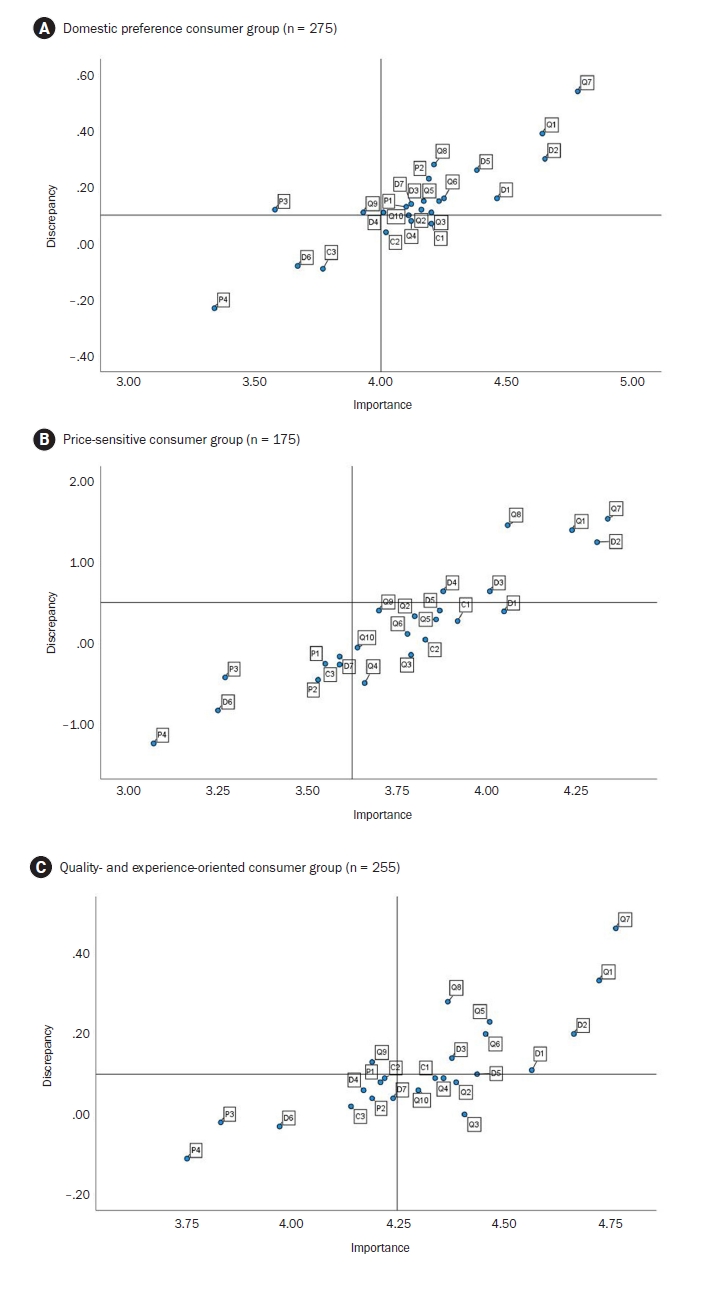Search
- Page Path
- HOME > Search
Research Articles
- [Korean]
- Analysis of pork consumption attribute factors by consumer lifestyle in Korea: a cross-sectional study
- Jounghee Lee, Juhyun Lee, Wookyoung Kim
- Korean J Community Nutr 2025;30(1):75-88. Published online February 28, 2025
- DOI: https://doi.org/10.5720/kjcn.2024.00332

-
 Abstract
Abstract
 PDF
PDF PubReader
PubReader ePub
ePub - Objectives
This study aims to identify and analyze how different South Korean lifestyles impact attitudes towards pork consumption.
Methods
We implemented a cross-sectional survey targeting 705 adult consumers in South Korea using hierarchical and K-means cluster analyses. Respondents were classified into three relevant lifestyles: (1) domestic preference, (2) price-sensitive, and (3) quality-experience-oriented. The importance-performance analysis was employed to evaluate discrepancies between how they rated pork consumption using factors of “importance” and “satisfaction”. We employed Borich’s needs assessment and the Locus for Focus model to prioritize management areas.
Results
The research findings highlight that unpleasant odor/smell (Q7) and hygiene (Q1) were common key areas for management across all consumer groups, emphasizing their importance in enhancing pork consumption satisfaction. Among the groups, the domestic preference group showed high importance-performance discrepancies in attributes like expiry date (D2), suggesting a need for strengthened trust in domestic pork distribution and information transparency. The price-sensitive group prioritized economic factors, with fat thickness (Q8) identified as an essential management area. The quality-experience-oriented group emphasized sensory qualities such as juiciness (Q6) and meat color (Q5), with off-flavors (Q7) displaying the largest discrepancy. These results show the significant role of sensory attributes in consumer satisfaction.
Conclusion
This study demonstrated the multidimensional nature of pork consumption behavior, emphasizing the need for tailored strategies across consumer groups. Managing hygiene (Q1) and reducing off-flavors (Q7) are critical for all segments, while group-specific strategies include managing sensory quality for the quality-experience-oriented group, providing product information (D2) to increase trust for the domestic preference group, and emphasizing value for money for the price-sensitive group.
- 591 View
- 32 Download

- [Korean]
- Development and Effectiveness Evaluation of the STEAM Education Program on Food Groups for Kindergarteners
- Jinkyeong Ahn, Seyoen Kim, Donghyuk Kim, Jounghee Lee
- Korean J Community Nutr 2022;27(5):361-372. Published online October 31, 2022
- DOI: https://doi.org/10.5720/kjcn.2022.27.5.361
-
 Abstract
Abstract
 PDF
PDF - Objectives
The purpose of this study was to explore the effectiveness of the STEAM (Science, Technology, Engineering, Arts, and Mathematics) education program on the use of specific food groups in improving nutrition-related knowledge and attitude, dietary behavior, creative problem solving, and STEAM attitude.
Methods
We selected two classes at a kindergarten in Jeollabuk-do, South Korea. A total of 44 kindergarteners from the two classrooms participated in this study. The experimental group and the control group were formed with 22 students each. The experimental group attended 11 STEAM classes on the use of the grain, fruit, and milk food groups. First, we performed the paired t-test to examine changes from pre-to-post classes for both groups. Then, we used ANCOVA to compare post-test scores between the experimental and control groups with the adjustment of pre-test scores.
Results
The results demonstrate that the STEAM education program on the use of the food groups significantly improved (1) nutrition-related knowledge and attitude, and dietary behavior (P < 0.001), (2) creative problem solving (P < 0.001), and (3) STEAM attitude (P < 0.001) in the intervention group when compared with the control group.
Conclusions
The STEAM education program on the use of food groups is effective in enhancing nutrition knowledge and attitude, dietary behavior, creative problem solving, and STEAM attitudes among kindergarten students.
- 661 View
- 21 Download


 KSCN
KSCN
 First
First Prev
Prev



